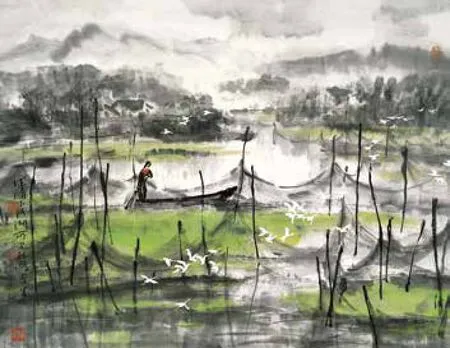Let There Be Light: Landscape by Liu Zupeng
2016-03-18BySunKe
By Sun Ke
Let There Be Light: Landscape by Liu Zupeng
By Sun Ke

《黄河绝唱》Ode to the Yellow River, an artwork by Liu Zupeng
Huzhou-based painting artist Liu Zupeng is best at presenting the engaging ‘water town’ quality of Jiangnan or the south of the Yangtze River Delta. In Liu’s landscape is his sentimental attachment to the land where he has settled down not only physically but also spiritually. The water town vista of Huzhou is a reliable source of inspiration and passion for the artist. His attainments as an artist are vivid illustration of the motto that “genius is one percent inspiration and ninety-nine percent perspiration”.
Liu’s ink-wash landscape works are noticeably ground-breaking. His style is unique. It is totally different from that of the landscape artists in northern China. It can be categorized as ‘maverick’ even when compared with the style of the mainstream ink-wash painters in Zhejiang. It is not hard to understand the difference in artistic presentation engendered by geographical features. For example, the smudging effect on the Chinese rice paper can be very different between a piece done in Beijing, where the air is mostly dry throughout the year, and a piece done in Hangzhou, where rain is a constant throughout the year. One of the trends in recent years among the artist circles of Zhejiang and Jiangsu is to make the ink effect as light and ethereal as possible, resulting in more difference in styles between the ‘northerners’ and the ‘southerners’. Such increasing difference adds color and variety to the art of traditional Chinese landscape painting. Liu has shown he has what it takes to give traditional Chinese landscape painting new perspectives by portraying the inviting Jiangnan elements in a beautifully unadorned, but highly conclusive way.
The unique ink-wash style of Liu Zupeng can be boiled down to ‘effortlessness’ and ‘simplicity’. At first sight, Liu’s ink-wash may strike one as a ‘careless mess’ and ‘disastrously unsystematic’. His ink-wash creation is everything but ‘orthodox’. However, the artist has found a unique conceptual approach to portraying the misty, phantasmagoric beauty of Jiangnan. Essentially, his works feel as soothing as the first glows of sunrise and as indescribably heart-warming as a beautiful dream.
Interestingly, ‘light’ seems to have long been the Achilles heel of the art of traditional Chinese painting, until the Ming painting artist Gong Xian boldly broke the norms to present ‘light’ by using heavy layers of ink. Another ‘light’ innovator was Li Keran, one of China’s traditional landscape painting masters of the 20th century. Liu Zupeng, however, produces ‘light’ and ‘shadow’ ina unique taste, as highly suggestive in such representative works as A Morning Scene in Jiangnan, Thawing Spring and Xiazhu Lake in Drizzles.
Light and shadow are a hallmark of Liu’s impressionistic landscape. His brushwork creates on a piece of rice paper a world of impressions. His works are said to be endowed with poetry.
Pu Zuoying (1832-1911), an artist of Jiaxing, a city near where Liu lives, is a predecessor whose footsteps Liu Zupeng has followed. Pu was an artist ahead of his time. His style looked wild, carefree, ebullient and impressionistic. Few of his contemporaries understood him. After he passed away, however, more and more people began to see the beauty in his works. Pu’s carefree grace was deeply rooted in his understanding of nature and art. Liu’s works convey a similar buoyant spirit that cares little about stereotypes and norms and explores the unknown and the unusual.
Liu’s freehand and impressionistic pursuit in ink-wash landscape is neither shallow nor unperceptive. His style has taken shape through hard work and tireless exploration. He has done field studies and conducted sketching trips in river towns and wetlands. He has experimented his skills and expressions in landscape and flower-bird paintings. Admirable is his refusal to follow the crowd mentality in his artistic quest.
Living in a land where rivers crisscross and ponds and lakes are like pearls seen almost everywhere, the artist, now 74 of age, still feels enamored of water. This partly reflects his understanding of this element of nature. About 2,500 years ago, Lao Zi said in his timeless “Dao De Jing” that “celestial kindness is like water.” This is probably the earliest Chinese philosophical understanding of the relationship between nature and man. Landscape painting in ancient China and today are largely about mountains and rivers, a convincing testimonial that Chinese people are as passionate with water as Lao Zi was. His mid-age years, Liu traveled along a few rivers across the country to see how water looked like. A number of masterpieces testify to his experience. Trickling streams, broad rivers, huge waves, and quiet lakes come together to portray his worldview of water.
A versatile artist, Liu also paints flowers and birds. Ducks are his favorite: they are energetic and free creatures frequently seen in rivers and ponds in this part of China. Artists in the south of China prefer to portray them in their works. Liu’s ducks present movement and spirit in fresh perspective. One of his duck paintings won an excellence prize at the 2nd National Flower-Bird Painting Exhibition.

《微雨中的下渚湖》Xiazhu Lake in Drizzle, an artwork by Liu Zupeng
Liu’s art emphasizes his uniqueness. He strives to be different from other artists and he follows his own heart.
